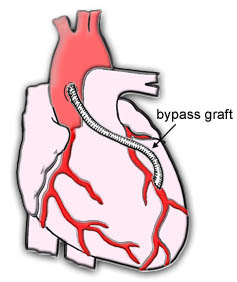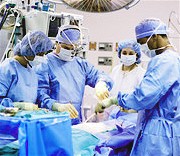Bypass surgery is the most common type of heart surgery with more than 200,000 procedures performed each year in the United States.
 Arteries can become clogged over time by the buildup of fatty plaque. Bypass surgery improves the blood flow to the heart with a new route or "bypass" around a section of clogged or diseased artery.
Arteries can become clogged over time by the buildup of fatty plaque. Bypass surgery improves the blood flow to the heart with a new route or "bypass" around a section of clogged or diseased artery.
The surgery involves using a section of blood vessel from the leg, chest, or another part of the body to graft onto the affected coronary artery, thus bypassing the clogged or diseased section.
During bypass surgery, the breastbone (sternum) is divided, the heart is stopped, and blood is sent through a heart-lung machine. Unlike other forms of heart surgery, the chambers of the heart are not opened during the operation. Some bypass procedures can be done as limited-access surgery, described below as minimally invasive bypass.
What to Expect
The operation will be scheduled at a time that is best for you and your surgeon, except in urgent cases. Be sure to tell your surgeon and cardiologist about any changes in your health including symptoms of a cold or the flu. Any infection may affect your recovery.
Also, review all medications (prescription as well as over-the-counter and supplements) with your cardiologist and surgeon.
Before surgery, you may have to have an electrocardiogram (ECG or EKG), blood tests, urine tests, and a chest x-ray to give your surgeon the latest information about your health.
If you smoke, your doctor will want you to stop at least 2 weeks before your surgery. Smoking before surgery can lead to problems with blood clotting and breathing.
The night before surgery, you will be asked to bathe to reduce the amount of germs on your skin.
A medicine (anesthetic) will make you sleep during the operation. This is called "anesthesia." Because anesthesia is safest on an empty stomach, you will be asked not to eat or drink after midnight the night before surgery. If you do eat or drink anything after midnight, it is important that you tell your anesthesiologist and surgeon.
You will get complete instructions from your cardiologist and surgeon about the procedure, but here are some basics you can expect as a bypass patient.
Day of Surgery
Most patients are admitted to the hospital the day before surgery or, in some cases, on the morning of surgery.
Small metal disks called electrodes will be attached to your chest. These electrodes are connected to an electrocardiogram machine, which will monitor your heart's rhythm and electrical activity. You will receive a local anesthetic to numb the area where a plastic tube (called a line) will be inserted in an artery in your wrist. An intravenous (IV) line will be inserted in your vein. The IV line will give you the anesthesia during the operation. You will be given something to help you relax (a mild tranquilizer) before you are taken into the operating room.
After you are completely asleep, a tube will be inserted down your windpipe and connected to a machine called a respirator, which will take over your breathing. Another tube will be inserted through your nose and down your throat, into your stomach. This tube will stop liquid and air from collecting in your stomach, so you will not feel sick and bloated when you wake up. A thin tube called a catheter will be inserted into your bladder to collect any urine produced during the operation.
A heart-lung machine is used for most bypass operations. A perfusion technologist or blood-flow specialist operates the machine. Before you are hooked up to this machine, a blood-thinning medicine called an anticoagulant will be given to prevent your blood from clotting. The surgical team is led by the cardiovascular surgeon and includes other assisting surgeons, an anesthesiologist, and surgical nurses.
After you are hooked up to the heart-lung machine, your heart is stopped and cooled.
A long piece of vein from your leg (the saphenous vein) may be removed for the graft. One end of the graft will be attached to the ascending aorta, the large artery that carries oxygen-rich blood out of the top of the heart to the body. The other end of the graft will be attached to the affected coronary artery below the blocked area. The surgeon may choose to use an artery from the inside of your chest wall (the internal mammary artery) instead. Or the surgeon may use both for grafts. The procedure can take from 2 to 6 hours, depending on the number of bypasses needed.
|
|
|
View of a coronary artery bypass operation from observation dome overhead.
|
|
Recovery Time
You can expect to stay in the hospital for about a week, including at least 1 to 3 days in the Intensive Care Unit (ICU).
Life After Bypass
After bypass surgery, your doctor will recommend that you join a cardiac rehabilitation program. These programs help you make lifestyle changes such as modifying your diet, exercising to get your strength back, quitting smoking, maintaining a healthy weight, and learning to deal with stress.
Because bypass surgery does not cure the underlying heart disease (atherosclerosis or coronary artery disease), medicines will be an important part of your treatment after the surgery. You will most likely need to take a statin or other cholesterol-lowering medicines and begin antiplatelet therapy.
If you have an office job, you can usually go back to work in 4 to 6 weeks. Those who have more physically demanding jobs may need to wait longer. In some extreme cases, you may need to find a job that is not as physically demanding. Twenty to 30% of bypass patients will need a second procedure within 10 years.
Minimally Invasive Bypass
Minimally invasive coronary artery bypass surgery is done through smaller incisions and the procedure may be done without stopping the heart. Some patients can even leave the hospital within 48 hours. This operation is only used for patients whose blockages can be bypassed through this smaller incision and whose risk of complications is low. See Limited Access Heart Surgery for more details.
See also on this site:

See on other sites:
MedlinePlus
https://medlineplus.gov/coronaryarterybypasssurgery.html
Coronary Artery Bypass Surgery
Updated August 2016



